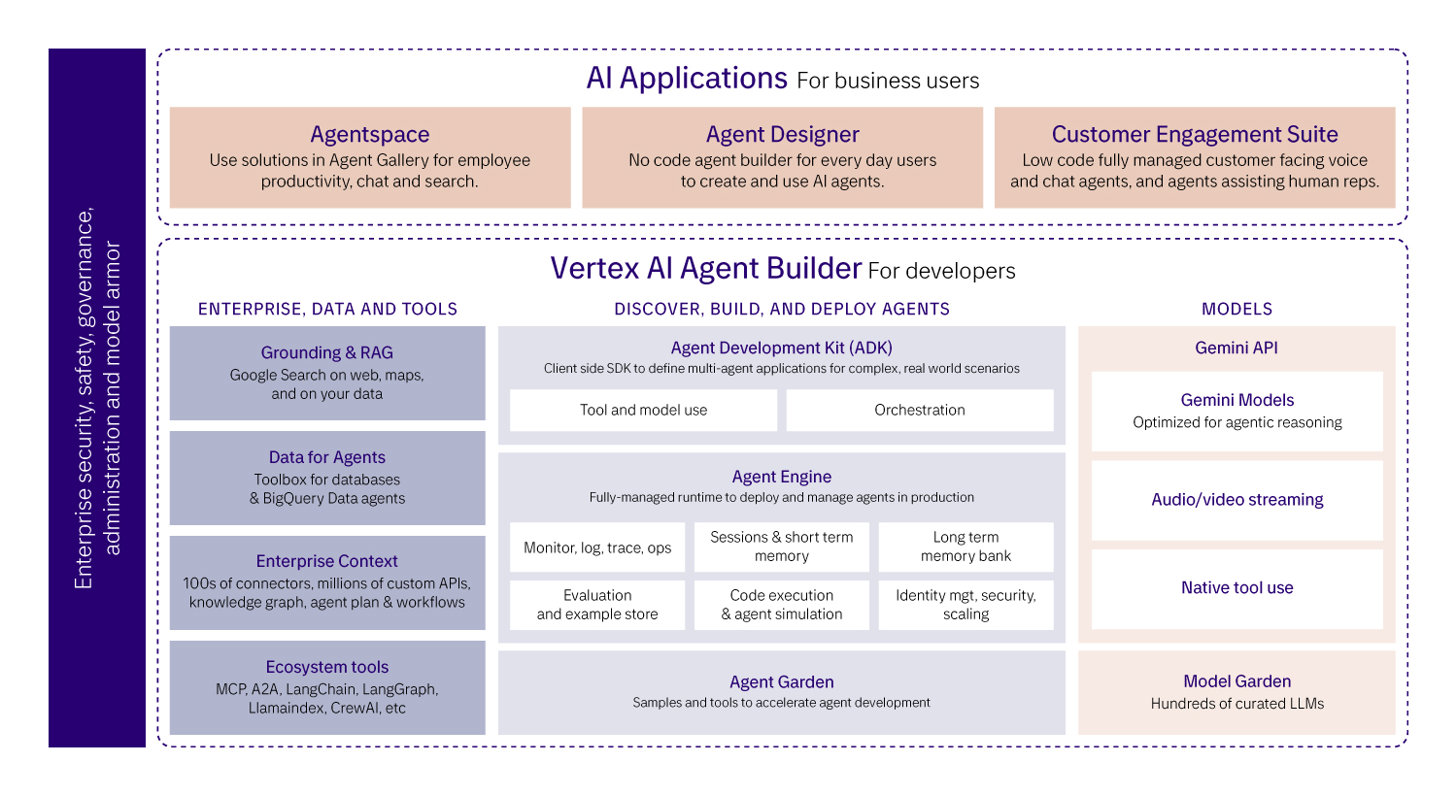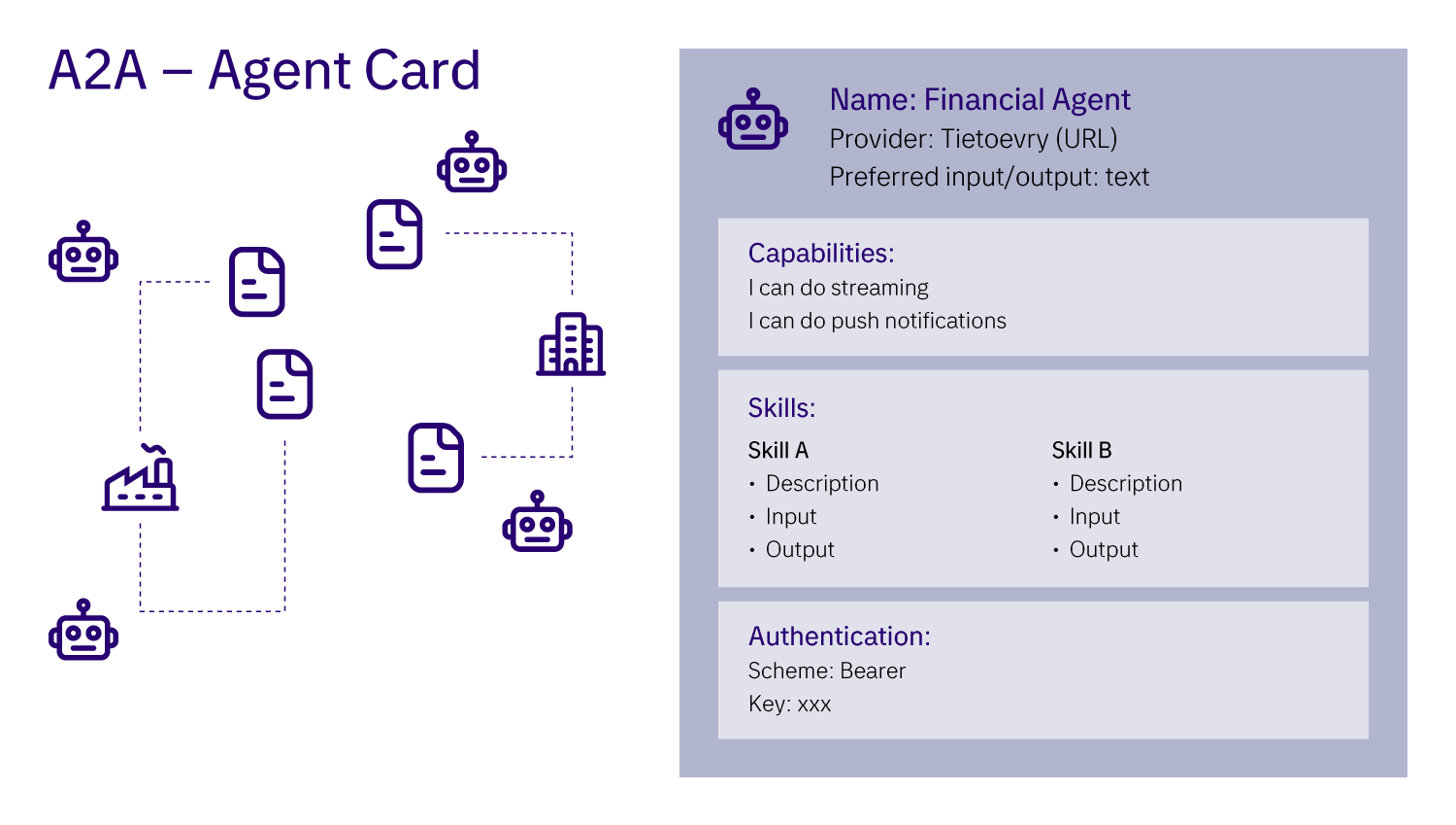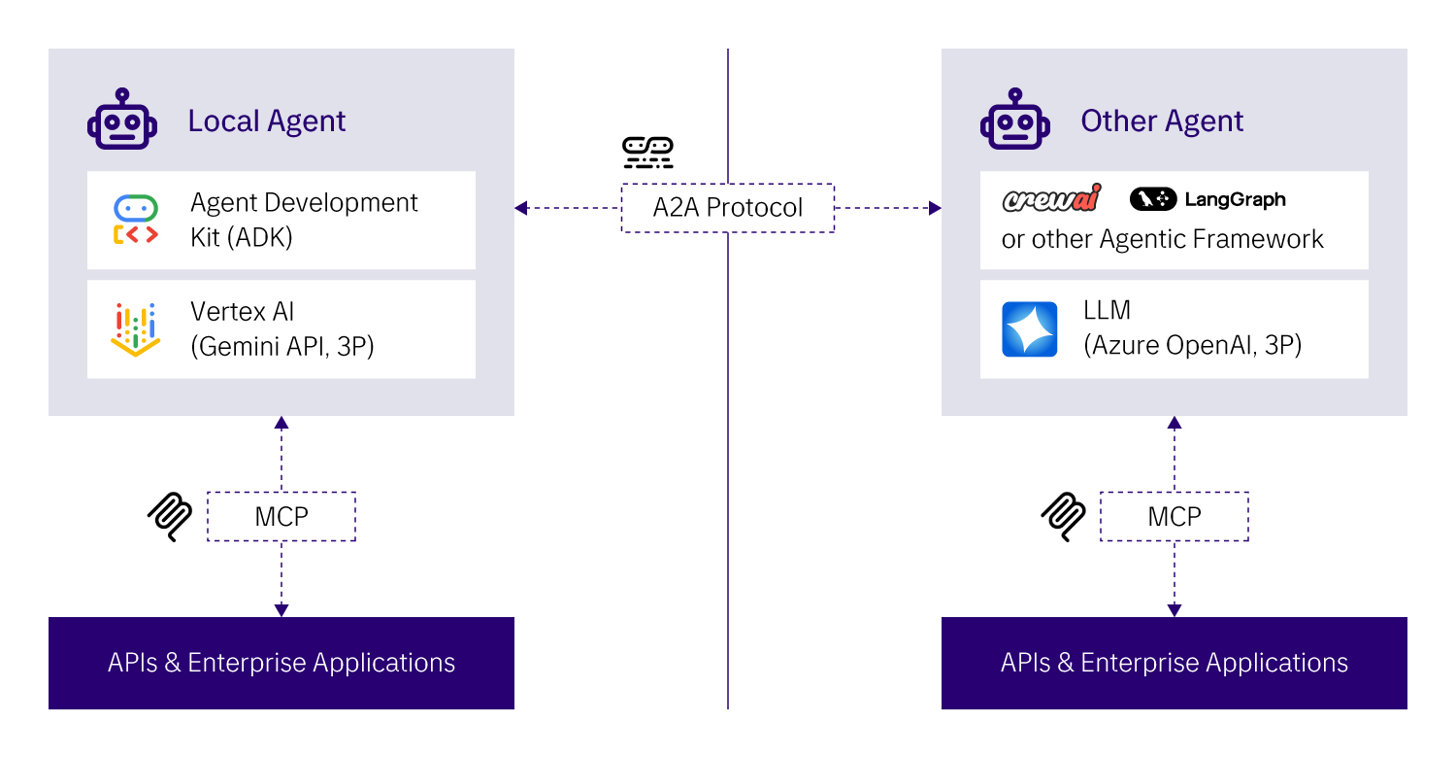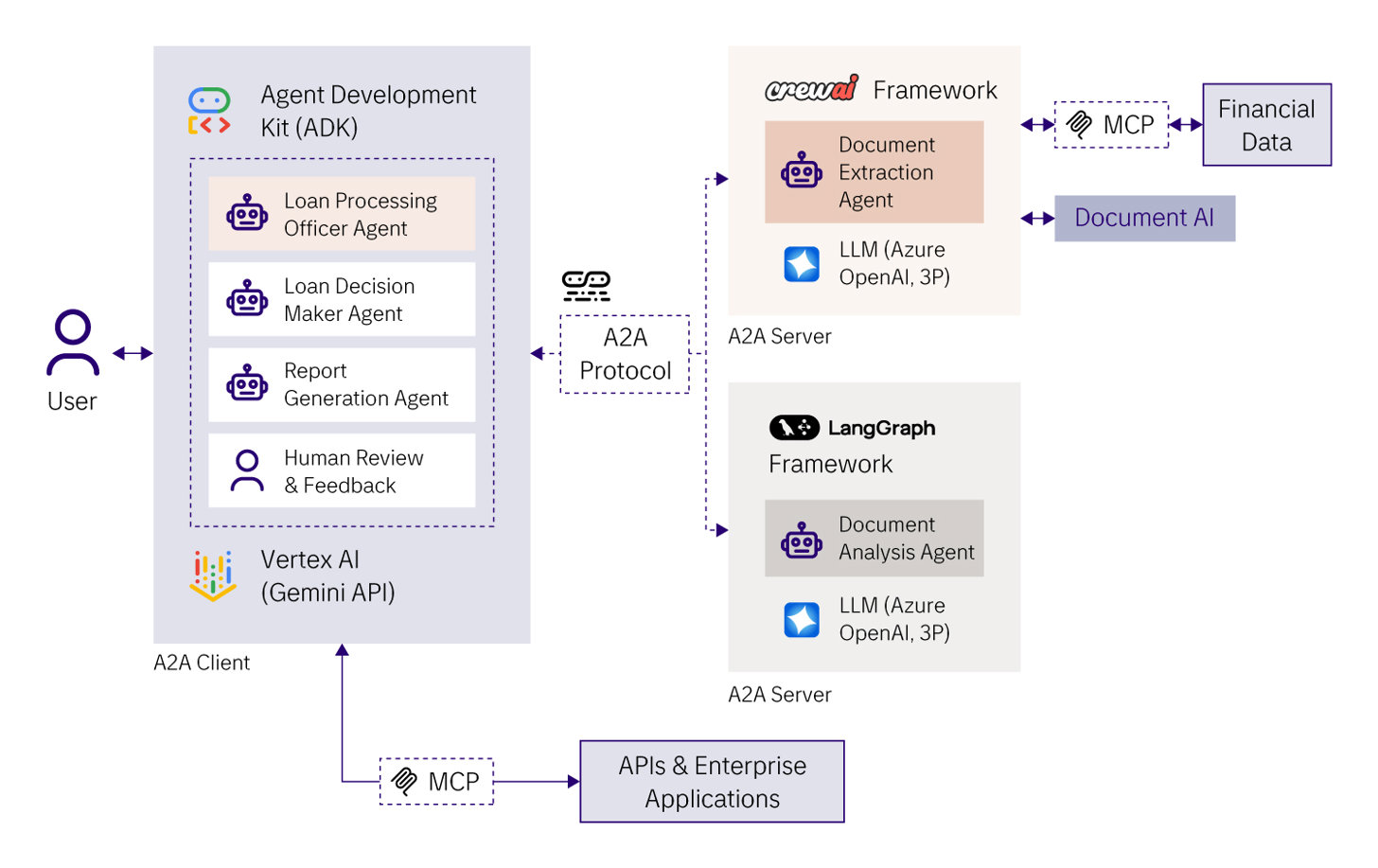
Building intelligent multi agents with Google AI services
Discover how Google’s AI agent architecture, powered by ADK, A2A, and MCP, enables rapid innovation by transforming isolated automation into intelligent, multi-agent collaboration.
Modern enterprises operate on complex, dynamic workflows that span multiple departments, systems, and decision points. This complexity and interdependence become a significant challenge when it comes to automation, since processes rarely exist in isolation.
This is where Agentic AI comes in, transforming enterprise operations. Cutting-edge AI automation solutions can operate either autonomously, alongside humans, or in coordination with other AI agents to achieve shared objectives. Like human employees, AI agents communicate, delegate tasks, and share knowledge with one another within their areas of responsibility. They can even discover each other’s capabilities and form digital teams, working across enterprise systems, external APIs, and data sources to execute complex, multi-step workflows.
Rather than automating isolated tasks, multi-agent systems orchestrate entire workflows, reducing manual effort, improving accuracy, and accelerating operations. Just as no single employee can handle everything, no single agent can either. But collaboration makes it possible.
The Game-Changing Trio: ADK, MCP, and A2A
Google, one of the tech giants that push AI forward, makes building AI agents a much simpler task than it could have been thanks to its own AI development platform. Google Vertex AI is one of the specialized tools from a tech vendor that enables businesses to build, deploy, and scale generative AI applications. Alongside Vertex AI, enterprises can benefit from a newly introduced Agent Builder that encompasses an entire ecosystem of tools to create AI agents quickly and efficiently.
The following graph illustrates Vertex AI's agent-building ecosystem, showcasing low-code/no-code and pro-code solutions for business users and advanced development tools for technical teams.

Core components of this ecosystem include ADK (Agent Development Kit) that provides the foundation for intelligent agent behaviour, MCP (Model Context Protocol) used to standardize external system communication, and A2A (Agent-to-Agent) that enables dynamic agent collaboration.
Agent Development Kit (ADK) is a framework for building, deploying, orchestrating, and scaling an Agentic system. It handles all the heavy lifting from agent behaviour and lifecycle management to memory, and tool integration, while enabling multi-agent workflows that can run sequentially, in loops, or parallel. Think of it as the brain that keeps your agents organized and purposeful. It seamlessly integrates with Google GenAI services, AI Service, and cloud services.
Model Context Protocol (MCP) standardizes how agents connect to external systems, APIs, data sources, and tools. Instead of building custom integrations for each connection, developers can use MCP as a universal communication layer. It significantly expands an agent’s capabilities by enabling dynamic interaction with external environments, standardizes how context flows into agents, and reduces integration development time.
Agent-to-Agent (A2A) Protocol is a breakthrough in multi-agent architecture. This open standard lets multiple agents communicate and collaborate with each other, regardless of who built them or what framework they use. It enables AI Agents to advertise their capabilities via "Agent Cards" or digital business cards and, as a result, establish secure, dynamic, inter-agent collaboration.
Together, ADK, MCP, and A2A form a layered architecture that powers intelligent, interoperable multi-agent systems. Access to a broader set of services from Google Cloud Platform (GCP) further enhances AI agents through native integration with its AI services, infrastructure primitives, enterprise-grade security, automatic scaling, and comprehensive monitoring.
How A2A Transforms Agent Collaboration
Previously, building agentic systems meant creating isolated applications with custom integrations. A2A transforms it into an ecosystem, where AI agents can discover and work with each other dynamically. This new level of collaboration eliminates siloed functionality or brittle integrations thanks to standardized protocols. Meaning, that now your document extraction agent can seamlessly collaborate with your document analysis agent, even if they were built by different teams using different frameworks.
The A2A system enables seamless communication between AI agents through standardized agent cards that define each agent's capabilities, skills, and authentication parameters for secure inter-agent collaboration.

However, this new framework requires a new approach to solution architecture to highlight agentic AI capabilities. Now, instead of building monolithic agents, we design specialized agents that excel in specific domains and coordinate via A2A. The following multi-agent system design pattern depicts how the Local Agent communicates with the Remote Agent. The real power lies in its layered design – three tiers (ADK, A2A, and MCP) working together to enable seamless agent interoperability. As a result, agent development time drops from weeks to days without compromising the effectiveness of the solution.

Real-world Impact: Transforming Loan Processing Workflow
An AI-driven loan processing workflow showcases the power of the A2A architecture with an agentic solution created to streamline document management, analysis, decision-making, and reporting. At the core of the system is the Loan Processing Officer Agent, an Orchestrator that manages the entire workflow and delegates tasks to specialized agents based on the document type and processing needs. Enabled by the A2A protocol, these agents, even though built on different frameworks, communicate seamlessly, ensuring accurate, efficient, and transparent loan processing from submission to final decision.
The flow of the various components of the loan processing multi-agent system is shown in the following diagram.

The entirety of the loan processing workflow includes the following agents:
- Loan Processing Officer Agent/Orchestrator (ADK framework): Acts as the central coordinator. When a user submits loan documents, this agent routes tasks to the appropriate sub-agents.
- Document Extraction Agent (CrewAI-based): Automatically processes submitted files such as income proofs, credit scores, and bank statements. It extracts structured content and validates document authenticity, preparing clean data for further analysis, and passes the extracted document content to the Loan Officer Agent.
- Document Analysis Agent (LangGraph-based): Analyzes the structured data passed from the Loan Officer Agent, identifying patterns and extracting key financial and personal insights necessary for assessing loan eligibility.
- Loan Decision Maker Agent (ADK framework): Applies the bank’s disbursement policies to make informed loan decisions. It evaluates client eligibility using the analyzed data and ensures compliance with financial rules.
- Report Generation Agent (ADK framework): Creates a comprehensive report that highlights positives and negatives, providing transparency and clarity on the loan evaluation.
- Human Review & Feedback: Ensures human oversight remains integral to the process, taking final decisions on complex cases and continuously refining the system based on feedback, creating a learning loop that improves accuracy over time.
Introducing AI agents into a complex loan processing workflow helps to:
- Reduce processing time from weeks to days.
- Significantly mitigate errors compared to manual review.
- Expand agents’ capability thanks to a modular design.
- Improve customer satisfaction thanks to reduced time.
Conclusion
Google’s Agentic AI ecosystem, powered by ADK, MCP, and A2A, marks a significant leap in how enterprises can design intelligent, collaborative systems, empowering teams to innovate with speed and precision. By enabling AI agents to reason, communicate, and coordinate across complex workflows, organizations can transform fragmented automation into fully orchestrated, end-to-end processes. With robust cloud infrastructure and open protocols, enterprises can move from siloed intelligence to dynamic, multi-agent ecosystems. The future of enterprise AI isn’t isolated – it’s collaborative, connected, and built to scale.

Ilanchezhian is a technology leader and skilled IT professional with 25+ years of experience in software solutions. He has extensive expertise in architecting Cloud, CAI, NLP & enterprise solutions, and product management from vision to implementation. In his current role as a Principal Architect in Digital Innovation, Ilanchezhian leads worldwide initiatives for conversational AI.

Krithika Subramani is the Executive Sponsor of Banking and Financial Services Business Unit and Digital Innovation practice in India. Krithika is a seasoned leader in the Digital realm with over 23 years of experience in building large scale cloud-based solutions for Fortune 500 companies. She has led global teams in their efforts to boldly reimagine experience for multiple clients across industries and markets.



